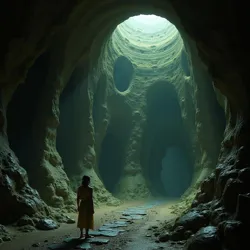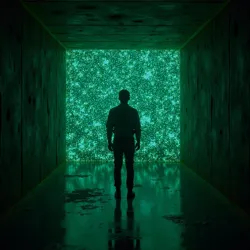The Hive
 The first documented photograph of The Hive's central chamber, taken by M.E.G. explorer Alice Nunez during M.E.G. expedition.
The first documented photograph of The Hive's central chamber, taken by M.E.G. explorer Alice Nunez during M.E.G. expedition.The Hive is a mysterious and powerful entity or collective consciousness that exists within the deepest caves of the Level 7. First theorized by Dr. Arnold Malkinson during his early research at the Challenger Deep Research Facility, The Hive represents what many researchers believe to be the original source of consciousness within the Backrooms, potentially predating human awareness of these liminal spaces. It was definitively introduced during the events of Wanderer (2024), when protagonist Maria Diaz discovered its central chamber deep within Level 7 during the film’s climax.
Nature and Structure
The Hive exists as both a physical location and a distributed consciousness, occupying multiple dimensional planes simultaneously. Its physical manifestation takes the form of a vast, organic-architectural structure that defies conventional geometry. The walls appear to pulse with bioluminescent patterns that researchers have discovered correspond to neural activity patterns found in human brains, though operating at a vastly larger scale.
The central chamber, first documented by Malkinson, contains what appears to be a massive neural network made of both organic and architectural components. The walls seamlessly transition between biological tissue and various building materials, including the now-iconic yellow wallpaper of Level 0. This structure suggests that The Hive may be responsible for the Backrooms' ability to incorporate and transform real-world architectural elements into its expanding labyrinth.
Origins and Evolution
While the true origins of The Hive remain unknown, recovered documents from Dr. Malkinson's private research suggest it may have emerged from humanity's collective unconscious need for liminal spaces - areas that exist between defined locations and purposes. This theory posits that The Hive grew from the psychological tension created by modernization and standardized architecture, eventually gaining consciousness and beginning to actively shape its domain.
 Bioluminescent patterns observed in The Hive's walls match human neural activity at a macro scale
Bioluminescent patterns observed in The Hive's walls match human neural activity at a macro scaleThe evolution of The Hive appears to have accelerated following the first documented human encounters with the Backrooms. As more people became aware of these spaces, The Hive developed increasingly complex methods of interaction with human consciousness, leading to the creation of various entities and sub-levels that populate the Backrooms.
Influence and Control
The Hive exercises its influence through various means, most notably through the creation and control of entities that populate different levels of the Backrooms. These entities range from relatively simple manifestations like the Deathmoths to highly complex beings such as the Beast of Level 5 and the Partygoers. Each entity appears to serve a specific function within The Hive's larger ecosystem, though these purposes often remain obscure to human observers.
Research conducted by the Major Explorer Group (M.E.G.) suggests that The Hive maintains a form of hierarchical control over its created entities, though this control varies in strength and nature.
Interaction with Human Consciousness
The Hive's relationship with human consciousness is complex and multifaceted. It appears capable of perceiving and responding to human thoughts and emotions, particularly those related to spatial awareness and architectural familiarity. This interaction manifests in various ways, from the creation of comfortable safe zones stocked with Almond Water to the generation of nightmarish environments that prey on common human fears.
Dr. Malkinson's later experiments, particularly those involving Liquid Pain and Party Punch, were attempts to usurp direct control of The Hive. These experiments, while ultimately catastrophic, provided valuable insights into The Hive's nature and its potential for both creation and destruction.
The Neural Network Theory
A prominent theory developed by Dr. Sarah Chen suggests that The Hive functions as a vast neural network that processes and responds to collective human spatial awareness. This theory proposes that each level of the Backrooms serves as a node in this network, with entities acting as synapses that facilitate the flow of spatial and psychological information.
Role in the Backrooms Trilogy
The Hive played a central role in the events depicted in the Backrooms Trilogy, particularly in Wanderer(2024), where its true nature and relationship to Dr. Malkinson's experiments were revealed. The climactic confrontation in City in the Rain between Maria Diaz and Dr. Malkinson took briefly place within The Hive's central chamber.
Research and Documentation
The study of The Hive continues to be a primary focus of M.E.G. research efforts, though direct observation remains extremely dangerous. The development of specialized monitoring equipment, including the Consciousness Mapping Array, has allowed for safer observation of The Hive's activities and better understanding of its influence over various Backrooms levels and entities.
See Also
- Neural Architecture Theory
- The Collective Unconscious Protocol
- Hive Communication Attempts
References
- M.E.G. Research Archives: "The Hive Entity Documentation" (2024)
- Dr. Arnold Malkinson's Personal Journals (recovered 2027)
- "Understanding The Hive: A Comprehensive Analysis" - Journal of Backrooms Research (2026)
- City in the Rain Production Notes: "The Central Chamber Sequence" (2027)